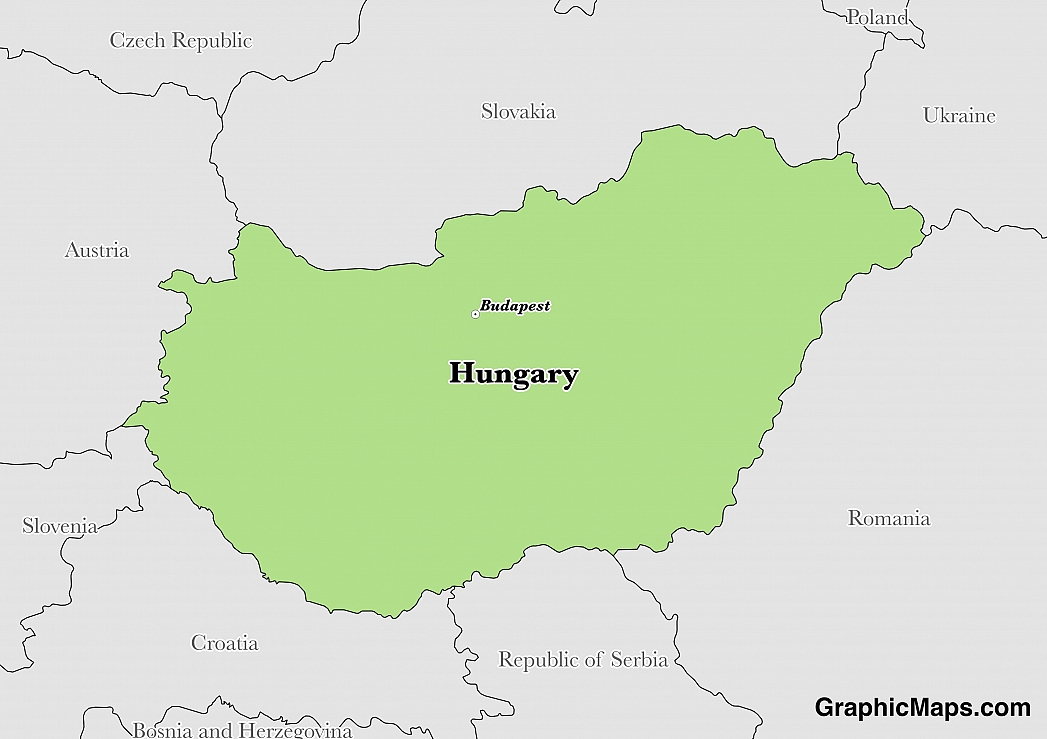Where is Hungary?
Located in Central Europe, Hungary has a 2,106.00 km border with Austria (321 km), Croatia (348 km), Romania (424 km), Serbia (164 km), Slovakia (627 km), Slovenia (94 km) and Ukraine (128 km). Negotiations continue between Slovakia and Hungary's failure to complete its portion of the Gabcikovo-Nagymaros hydroelectric dam project.
The capital city of Hungary is Budapest, formed in 1873 after three cities merged. It is the most populous city in Hungary, and where the country’s parliament building is located. Budapest is divided into two by Danube River, with a chain bridge connecting the two parts. The city itself is home to more than 1.7 million residents, with another 2.5 million people living in its metropolitan area. It is not just an economic hub of Hungary, but also a cultural and historic city that attracts tourists from all over the world. Budapest experiences summer sunshine since it lies within the humid continental climate under the Koppen climate classification.
Read more on Hungary's CapitalHungary is a European country covering 93,028.00 km2 of which 3.68% is water and 89,608.00 km2 is land. This makes it the 108th largest country in the world and slightly smaller than Virginia; about the same size as Indiana. Its geographic coordinates are 47 00 N, 20 00 E and Budapest is the capital city.
The name Hungary is said to come from the term "Oungroi", which later became "Hungari".
Its ISO code is HU.
Geography
Hungary has a mean elevation of 143 m above sea level.
It has a temperate climate that is cold and coudy in the winter and warm in the summer. Its terrain is mostly flat with some hills and low mountains near the Slovakian border.
Population
Hungary has a population of 9,874,784 making it the 90th largest in the world. The country sees a fairly even population distribution.
Hungarian is the official language. The major ethnic group reported is Hungarian. The majority of the country is Roman Catholic or unspecified.
The Hungarian language originally used to be written from right to left, gradually discarded by Stephen I of Hungary. Some identified dialects of Hungarian are Central Transdanubian, North-Eastern Hungarian, Paloc, Southern Great Plains, Tisza-koros, Western-Transdanubian, Oberwart, and Csango. The official language of Hungary is Hungarian, which is a finno-Ugric language. Hungarian is not related to most languages in Europe and is native to some countries. It is the most used language in Hungary, used by 99.6% of Hungary’s population. Hungarian is the 13th most spoken language in Europe. Hungarian has 14 vowels and 25 consonants. The vowels are 7, with only the pronunciation bringing out the differences. Other minority languages are also spoken in Hungary, like Serbian, Slovak, Slovene, Croatian, Romanian, Romani, Greek, English, and German. English and German are the most spoken foreign languages in Hungary.
Read more on Hungary's LanguagesThe dialing code for the country is 36.
Government
Hungary is an independent country. It proclaimed itself a republic in 1918. Its constitution was last ratified in 2011.
Hungary is a democratic republic, headed by the president as the headed of state. The president’s political activities are minimal, with the prime minister running the government. Both the president and the prime minister are independently elected by the parliament. A president’s term ends at five years, which is renewable only once. The Parliament of Hungary is located in Budapest, the country’s capital, and is sometimes referred to as the Parliament of Budapest due to its location. Construction of the building began in 1885 and ended in 1904. Budapest is also home to the President of Hungary, whose official residence, called the Sandor Palace, is located there.
Read more on Hungary's GovernmentEconomy
Factoring in Purchasing Power Parity, Hungary's GDP is $268,000,000,000.00 (USD) with $27,200.00 (USD) per capita. This makes it the 59th largest economy and its citizens the 66th richest in the world. The currency of Hungary is the Forint (HUF).
Its major export partners are Germany, Romania, and Slovakia. Its main exports are machinery and equipment, as wlel as food products. Its major import partners are Germany, China, and Austria. Its major imports include machinery and equipment, other manufactures, fuels, and electricity.
Flag
The flag of Hungary was adopted on 23rd May 1957 although the colors have been in use since 1816. The flag is a tricolor of red, white and green, all lying horizontally. It is stated that the flag was inspired by the French revolution and it originates from national republic movements in the 18th and 19th centuries. The colors have been romantically interpreted to mean different virtues where red means strength, white means faithfulness, and green means hope. The official meanings for the colors however are red for the blood spilled by Hungary in its many battles, white for freedom while green is for the land and pastures of Hungary.
Read more on Hungary's FlagThis page was last modified on January 17th, 2018
More on Graphicmaps

Published on 2019-11-06
What is a Trade Embargo?

Published on 2019-11-04
Which Two Countries Used to Have the Same Flag?

Published on 2019-09-16
What Is the Only Two-Sided State Flag?

Published on 2019-09-16
Which Country Flag Looks Like the Texas Flag?

Published on 2019-08-29
Flags That Resemble the US Flag

Published on 2019-08-20
